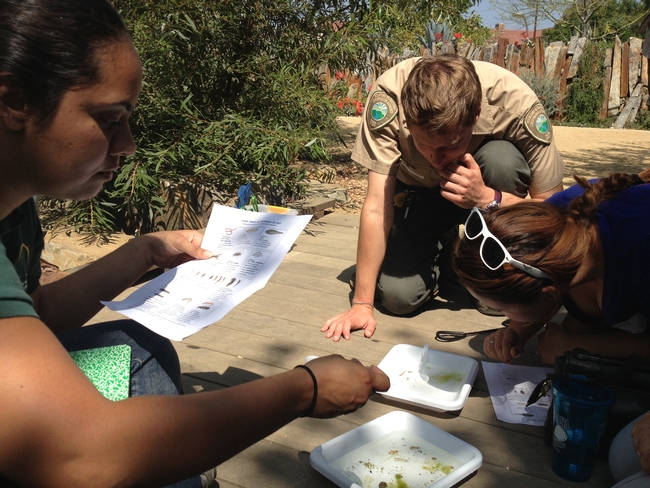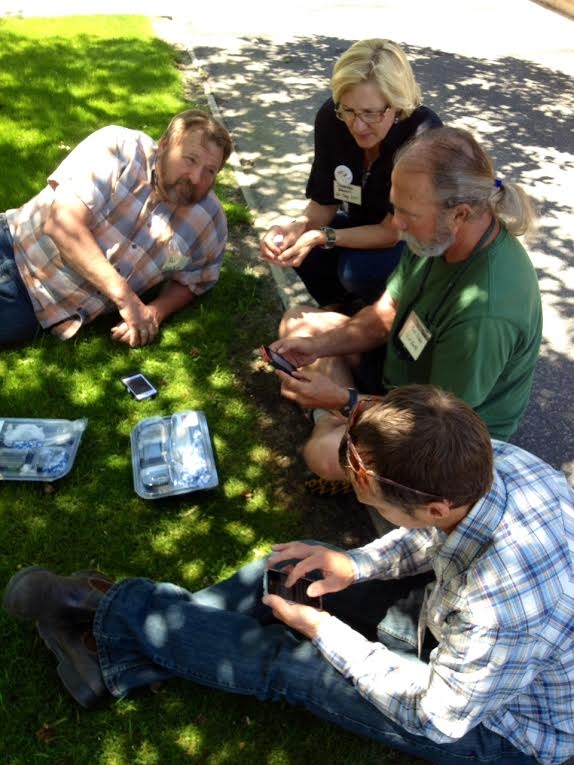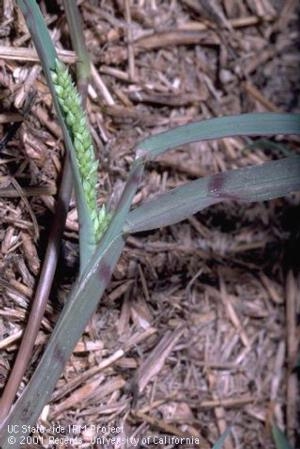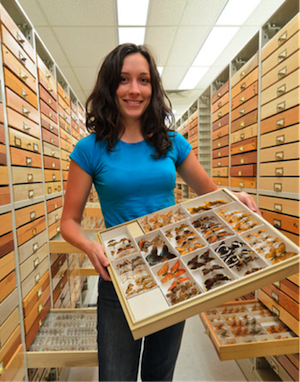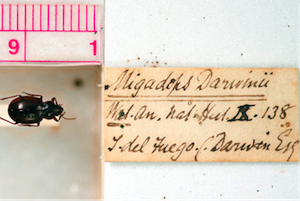Posts Tagged: citizen science
There are no passengers on spaceship earth. We are all crew.
"There are no passengers on spaceship earth. We are all crew" - Marshall McLuhan.
To understand and protect California's unique natural resources, we need all the information we can gather across many different disciplines. Citizen science is one crowd-sourced approach to gathering that information.
One of the first institutions to formally use the citizen science approach, Cornell Ornithology Lab, defines citizen science as projects in which volunteers partner with scientists to answer real-world questions. Another term to describe these projects, often used interchangeably, is “public participation in scientific research” (PPSR), which Cornell defines to include citizen science, volunteer monitoring, and other forms of organized research in which members of the public engage in the process of scientific investigations. We live in an increasingly connected world where the potential of citizen science to solve real-world problems is considerable.
The UC California Naturalist Program has incorporated citizen science in the training curriculum from the program's conception. One of the program's primary goals is to increase participation in resource conservation and citizen science projects throughout the state. It is not a leap to imagine how a scientifically informed public might also inform natural resource policy makers. Each partnering organization offering a California Naturalist certification course must adopt a class citizen science project so that each course participant gains experience in data collection and entry. Course participants also get introduced to the interactive, on-line iNaturalist tool, where users can record observations from nature, develop on-line species lists and journals, meet other naturalists, contribute to research-grade observations at the Global Biodiversity Information Facility, and “help scientists save the world!”
While some partner organizations already have an active go-to citizen science project, other partners may decide to choose a project from the California Naturalist Program's public, vetted online database of California citizen science and PPSR projects, the largest of its kind in this state. Additionally, each course participant must complete a service learning Capstone Project prior to certification and projects may focus on citizen science, education and interpretation, conservation and restoration, or program support. The searchable citizen science database is a useful tool to explore the myriad of citizen science opportunities, to get or stay involved in a particular field, and to keep developing new skills.
Another way that the California Naturalist Program contributes to citizen science is by participating in the development of organizations such as the new Citizen Science Association (CSA), a community of practice for the field of public participation in scientific research. CSA actively works to establish a global community of practice for citizen science, advance the field of citizen science through innovation and collaboration, promote the value and impact of citizen science, provide access to tools and resources that further best practice, support communication and professional development services, and foster diversity and inclusion within the field.
At this early stage, membership to the society
is free and they offer several ways to communicate on-line with the larger community. In February 2015 the California Naturalist Program will present at the CSA conference in San Jose both as part of a panel discussion on the use of citizen science in Master Naturalist-type programs across the U.S. and as poster presenters. Participants will spend two days building connections, exchanging ideas across a wide spectrum of disciplines and experiences, and shaping the future of citizen science. The predecessor to this conference, and the first of its kind to focus specifically on the field of citizen science, and its scientists, practitioners, educators, data managers and statisticians was held in 2012 in Portland, Ore.In addition to the use of citizen science for natural resource stewards, non-profits, and science hobbyists, teachers may also use citizen science as a hands-on learning tool to meet changing standards. California's process of adapting the Next Generation Science Standards (NGSS) for K-12 schools will create new citizen science opportunities throughout the state. With an emphasis on application and real world experiences, the new standards align perfectly with citizen science. Teachers can involve students in real life science while meeting the goals of NGSS.
For the citizen scientist or organization that is unconvinced the right project for their organization's goals or interests exists, the website citsci.org will assist with creating new citizen science projects. After a simple registration process, the website provides tools for the entire research process including creating new projects, managing project members, building custom data sheets, analyzing collected data, and gathering participant feedback. CitSci.org was developed through the Natural Resources Ecology Lab (NREL) at Colorado State University as an initiative to promote citizen involvement in scientific research. Another useful resource for citizen science project outcome evaluation is Cornell Ornithology Lab's new User's Guide for Evaluating Learning Outcomes from Citizen Science. This guide includes worksheets, templates, evaluation techniques, and tips for assessing project outcomes and creating a unique evaluation plan based on best practices.
UC asks for citizens' help with research
UC Cooperative Extension has sent out pleas to farmers, farm advisors, pest control advisors and others for contributions to two current research projects.
Lynn Sosnoskie, assistant project scientist in the Department of Plant Sciences at UC Davis, is asking for seed samples collected from mature junglerice plants to evaluate for glyphosate resistance, reported Todd Fitchette in Western Farm Press.
Resistance to glyphosate (best know by the brand name Roundup) in junglerice and other weeds is of particular importance to small-acreage, specialty crop farmers due to the limited availability of registered herbicides, the article said. Sosnoskie's study will determine the distribution of glyphosate-resistant junglerice, compare its resistance when grown in various environments, and evaluate alternative control strategies.
Details about collecting and sending the junglerice seed samples to Sosnoskie are found in the Western Farm Press article.
Neil O'Connell, UC Cooperative Extension advisor in Tulare County, is asking citrus farmers to complete a brief survey about the impact of the drought on their farming operations, reported Vicky Boyd in The Grower.
The survey, which does not require a name or address, queries farmers about their normal surface water allocation, this year's allocation, groundwater usage plans and irrigation plans.
You, Too, Can Be a Scientist!
You don't have to be a citizen to be a "citizen scientist," and you don't have to be a scientist to be a citizen. But "citizen scientist" is a...
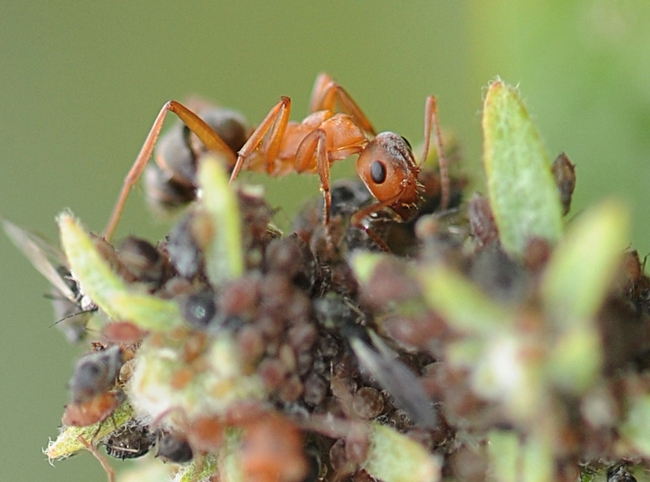
Formica moki, a native ant, frequents Yolo County gardens. (Photo by Kathy Keatley Garvey)
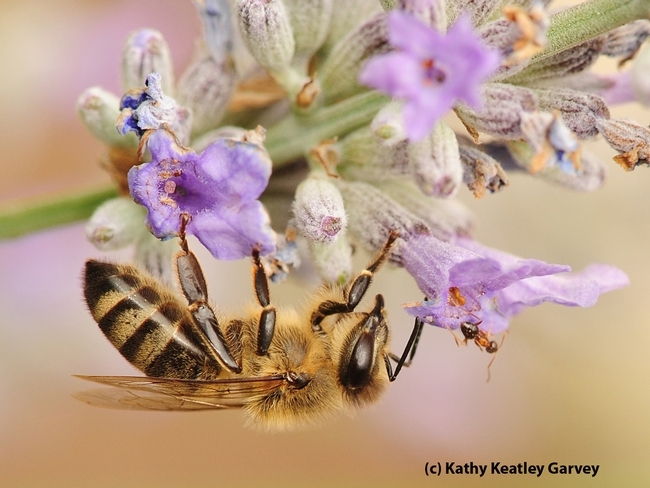
A honey bee and a velvety tree ant. (Photo by Kathy Keatley Garvey)
Help wanted: Public needed to uncover clues in natural history collections
Through Calbug, any volunteer with Internet access can help read and transcribe hand-written field notes accompanying a million insect specimens, many dating back more than 100 years.
Along the way, participants are getting a peek into history and the treasures held in museum collections. Among the many scientifically valuable objects in the Essig collection is at least one – a ground beetle from Tierra del Fuego, Chile – that was collected in 1833 by none other than Charles Darwin.
Calbug teamed up with two other natural history collections – one focused on plants and the other on birds – to create Notes from Nature, a citizen science project that draws on the public to tame the voluminous records stored in drawers, jars and bookshelves in natural history museums throughout the world. The project was officially launched last month.
“What really turns people on is knowing that they are contributing to science in a meaningful way,” said Calbug co-investigator Kipling Will, associate professor of Environmental, Science Policy and Management. “These citizen science projects speak to the importance of public engagement in science.”
“Without the help of citizen scientists, processing the sheer volume of records held in natural history collections — estimated to be well over 2 billion worldwide — would take generations,” added Rosemary Gillespie, director of the Essig Museum and principal investigator of the Calbug project.
Notes from Nature is among the many projects that fall under the umbrella of Zooniverse, a highly successful Web-portal where citizens can help answer a diverse array of scientific questions, such as how stars form, what whale calls mean, and what life was like in the ancient Egyptian town of Oxyrhynchus.
“Our projects help answer research questions that can only be solved by a significant amount of human attention — they require people, not computers,” said Arfon Smith, director of citizen science at the Adler Planetarium in Chicago and the technical lead for Zooniverse. “People have responded in a way that is truly great. There is an appetite for contributing to something real.”
In addition to insects, Notes from Nature participants can help digitize plant records from the Southeast Regional Network of Expertise and Collections (SERNEC). The SERNEC collections include thousands of specimen images, labels and ledgers from hundreds of herbaria in the Southeast United States.
The Calbug project originally began with support from a 2010 National Science Foundation grant to digitize the first I million — out of 6.5 million total — specimens from California’s eight major entomological collections. Besides UC Berkeley, Calbug includes insect collections from the California Academy of Sciences, UC Davis, UC Riverside, UC Santa Cruz, the California State Collection of Arthropods, Santa Barbara Museum of Natural History, San Diego Natural History Museum and the Los Angeles County Museum.
“California has a rich history of insect collecting dating back to around 1900 and earlier,” said Gillespie, a professor in UC Berkeley’s Department of Environmental Science, Policy and Management. “Through Calbug, our goal is to make at least some of those records, which are normally inaccessible to the public, available to people around the world. And by converting those labels into electronic records, it will be possible for us to track any changes in range for different species, and that provides insight into how animals react to changes in the environment.”
(BiGCB), an ambitious effort to analyze biological records during ancient and more recent episodes of environmental change to better forecast how plant and animal populations might adapt to our rapidly changing planet.
“We originally thought digitization would have to be done by brute force alone, which meant hiring undergrads to manually enter the data one record at a time,” said Will. “Even for a small portion of our collection, this would have taken many years to complete. By joining the Notes from Nature partnership, we expect to meet and exceed our goal, and in the process develop methods that other collections can adopt.”
Questions remain about the level of accuracy of the transcriptions entered by the citizen scientists. Researchers from the University of Colorado Museum of Natural History are working with Zooniverse to evaluate the cost, accuracy and speed of volunteer transcriptions from the Notes from Nature site.
Thanks to a beta launch in late April of the first 20,000 images, which included an array of insects like bombardier beetles and skipper butterflies, Calbug is already well on its way to completion. About a third of these records have already been transcribed by more than 2,000 users, including Maggie Sanders, a homemaker from Fuita, Colo., who has completed nearly 400 transcriptions since late April.
“I have no background in science whatsoever, but I love seeing patterns in nature,” said Sanders. “I’ve at least dabbled in about a dozen citizen science projects through Zooniverse. That’s the beauty of it all: there are no time requirements, no qualifications, just a few moments of training, and suddenly I’m transcribing ancient Greek papyri or describing galaxies or measuring fish. What I love about Citizen Science is that I feel like I’m part of something important. And then, after I make my daily contribution to science, I just turn off the computer and go back to making dinner or reading with the kids!”
California Naturalist Program grows a new constituency for nature
Have you heard of the UC ANR California Naturalist Program? This new UC ANR program fosters a diverse community of naturalists and promotes stewardship of California's natural resources through education and service. Designed to introduce Californians to the wonders of our unique ecology and engage volunteers in stewardship and study of California’s natural communities, California Naturalist provides hands-on instruction and exposure to real world environmental projects designed to inspire adults to become active citizen scientists and enhance their personal connection with the natural world.
The California Naturalist Program encourages Californians to help protect and preserve our unique and diverse wildlife, habitats, rivers, lakes and coastal resources, wild and urban alike. Currently, the program certifies naturalists through 10 partnering institutions statewide, and continuing education units/college credit are available. Becoming a California Naturalist is a commitment to life-long learning. Advanced training opportunities for naturalists are continually offered by California Naturalist partners and the University of California. The program is in the planning stages for a first bi-annual statewide conference in 2014.
California Naturalist’s newest course offerings include two summer 2013 in-residency intensive courses at Nevada County’s UC Berkeley Sagehen Creek Field Station (July 8 - 14, 2013) and Sonoma County’s Occidental Arts & Ecology Center (August 15 - 22, 2013). These residential summer courses provide a chance to immerse yourself in the wonders of California’s unique ecology. Through a combination of science curriculum, guest lecturers, field trips and project based learning, participants will advance their ability to observe and understand nature. Great for teachers, docents, environmental professionals, and everyone interested in natural history.
Please learn more about taking a class or becoming a partnering institution on the website, find us on Facebook or contact us directly at canaturalist@ucanr.edu or (707) 744-1424 Ext. 104.
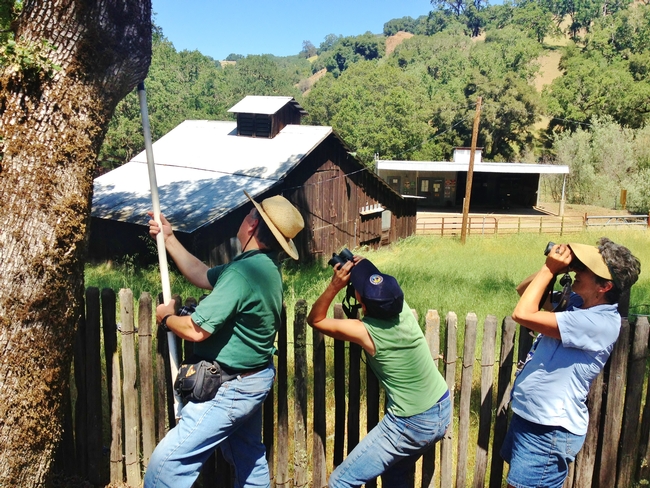
California Naturalists in-training participate in NestWatch, a nationwide monitoring program designed to track status and trends in the reproductive biology of birds.


